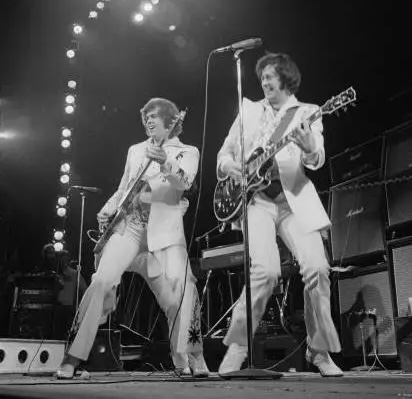The Osmonds, a family band best known for their clean-cut image and pop-friendly hits, shocked the world in 1972 with the release of Crazy Horses. Known primarily for their bubblegum pop and wholesome appeal, the group’s bold foray into hard rock caught both fans and critics off guard. Packed with heavy guitar riffs, thundering drums, and an environmental message, Crazy Horses stands as a testament to the Osmonds’ versatility and willingness to push boundaries.
The Osmonds: From Pop Icons to Rock Innovators
In the late 1960s and early 1970s, the Osmonds were riding high on their fame as pop sensations. Songs like One Bad Apple and Yo-Yo had cemented their reputation as teen idols. However, by the early 1970s, the landscape of popular music was shifting. Rock bands like Led Zeppelin, Deep Purple, and Black Sabbath were dominating the charts, and even pop artists were experimenting with edgier sounds.
The Osmonds, eager to break free from their squeaky-clean image, decided to explore a grittier, more rock-oriented style. This creative shift culminated in the 1972 album Crazy Horses, with the title track serving as its standout hit.
The Making of Crazy Horses
Inspiration and Message
Unlike their earlier love songs, Crazy Horses tackled an issue that was increasingly relevant in the 1970s: environmental pollution. The song’s title refers to the gas-guzzling cars of the era, which were seen as major contributors to air pollution. The lyrics criticize humanity’s reliance on fossil fuels, warning of the consequences if we fail to address the environmental damage caused by industrialization.
This thematic departure demonstrated the Osmonds’ awareness of global issues and their ability to craft meaningful, socially conscious music.
Musical Composition
The song’s hard-rock edge marked a stark contrast to the Osmonds’ previous work. Written by Alan, Merrill, and Wayne Osmond, Crazy Horses features:
•A powerful guitar riff: The distorted, grinding riff drives the song, giving it an unmistakable rock vibe.
•A distinctive keyboard hook: Played by Alan Osmond, the high-pitched keyboard effect mimics the sound of whinnying horses, adding a unique, almost surreal element to the track.
•Thunderous percussion: Jay Osmond’s drumming is aggressive and relentless, lending the song an intensity that rivals the era’s best rock bands.
•Gritty vocals: Merrill Osmond’s raw, almost shouted vocal delivery contrasts sharply with the polished harmonies the group was known for, further emphasizing the song’s rebellious tone.
Chart Success
Crazy Horses became an international hit, reaching the top 10 in several countries, including the UK, where it peaked at #2. In the US, it performed well on the Billboard Hot 100, solidifying the Osmonds’ status as more than just a pop group.
Critical Acclaim
While the Osmonds had often been dismissed by critics as lightweight pop stars, Crazy Horses earned them newfound respect. The song was praised for its boldness, both in terms of its sound and its message. Many saw it as proof that the Osmonds could hold their own in the rock world.
Fan Reaction
Longtime fans were divided. Some embraced the Osmonds’ new direction, while others struggled to reconcile the heavy sound of Crazy Horses with the group’s wholesome image. Despite this, the song attracted a new audience, including rock fans who had previously dismissed the Osmonds.
A Timeless Message
The environmental concerns addressed in Crazy Horses remain relevant today. The song’s critique of pollution and its call for change resonate in an era increasingly focused on climate action and sustainability.
A Rock Anthem
Crazy Horses has become a cult classic, celebrated for its raw energy and innovative composition. It’s often cited as one of the most surprising and impressive departures in pop music history.
Influence on Other Artists
The song has been covered by a wide range of artists, from heavy metal bands to punk rockers, demonstrating its broad appeal. Notable covers include those by the Sensational Alex Harvey Band, KMFDM, and Electric Six, each adding their unique spin to the track.
Pop Culture Presence
Crazy Horses has appeared in films, television shows, and commercials, further cementing its status as a cultural touchstone. Its iconic keyboard riff and driving rhythm make it instantly recognizable, even to those unfamiliar with the Osmonds’ discography.
Behind the Lyrics: Breaking Down the Environmental Message
The lyrics of Crazy Horses are direct and urgent, with lines like:
“What a show, there they go, smokin’ up the sky!”
The imagery of horses as a metaphor for polluting cars is both striking and memorable. By framing the issue in such a creative way, the Osmonds managed to deliver a serious message without sounding preachy.
At a time when environmental awareness was just beginning to gain traction, the song was ahead of its time, advocating for change long before the green movement became mainstream.
The Osmonds’ Transition and Reinvention
Crazy Horses wasn’t just a one-off experiment—it marked a turning point for the Osmonds. While they continued to produce pop hits, they increasingly incorporated rock and funk elements into their music.
This period of experimentation allowed the Osmonds to showcase their musical talent and versatility, earning them respect from
No comments yet.








